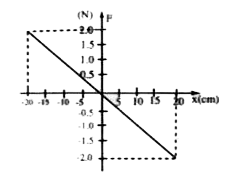A particle moving along the X-axis executes simple harmonic motion, then the force acting on it is given by
where, A and K are positive constants.Solution in Marathi
-A kx
A cos (kx)
A−kx
A kx
The correct Answer is:C
Step by step video & image solution for A particle moving along the X-axis executes simple harmonic motion, then the force acting on it is given by where, A and K are positive constants. by Physics experts to help you in doubts & scoring excellent marks in Class 12 exams.
Updated on:21/07/2023Similar Questions
The force acting on a particle moving along X-axis is F=−k(x−v0t) where k is a positive constant. An observer moving at a constant velocity v0 along the X-axis looks the particle . What kind of motion does he find for the particle?
View SolutionA particle of mass m moving along the x-axis is a potential energy U(x)=a+bx2 where a and b are positive constants. It will execute simple harmonic motion with a frequency dete by the value of:
View SolutionFigure shows the variation of force acting on a particle of mass 400g executing simple harmonic motion. Find the frequency of oscillation of the particle

View SolutionA particle moving along the X-axis executes simple harmonic motion, then the force acting on it is given by where, A and K are positive constants.
View SolutionThe differential equation of a particle executing simple harmonic motion along y-axis is
View Solution
Figure. Shows the variation of force acting on a particle of mass 400 g executing simple harmonic motion. The frequency of oscillation of the particle is
View SolutionA particle of mass m moving along x-axis has a potential energy U(x)=a+bx2 where a and b are positive constant. It will execute simple harmonic motion with a frequency determined by the value of
View Solution
